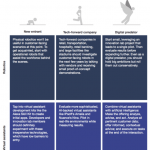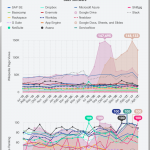A martech wish list: Where marketing clouds need to go
Columnist Jose Cebrian takes a look at the platforms that are currently available for large-scale marketing, particularly for email, and highlights what they’re missing and what would make them shine.

For marketers, messaging technology options abound out there, from complete marketing clouds to channel-specific options, such as email service providers (ESP) or push platforms. They all were designed around a particular customer and set of use cases, and their current versions often reflect that starting point and the evolution of their customer strategy.
In one aspect of my job, I get to look at the various platforms on the market to understand the different capabilities available for different use cases. My lens is generally focused on large-scale marketing, with an emphasis on email. With that in mind, I have created a wish list for platforms that view this as a target market. It should be noted that many platforms currently offer some of these features — but whether they’re full-fledged and practical or merely exist to help check a box on an RFP (request for proposal) is up for debate.
Content:
• Stop making us upload images and links separately and then repath them. It’s a waste of time. I want to be able to upload coded HTML and have the images automatically grabbed, put out on a CDN (content delivery network) and repathed in the email. If you are going to require me to spend more time creating a folder, allow me to set a naming convention at the macro level (that the platform can suggest).
The same is true for links. Links should be put into a link table automatically, and then I should have the ability to change information about that link within the table.
• Integrate with large-scale digital asset management platforms. Similar to the above — if you already have the content, don’t force me to make it conform to your needs.
• Improve dynamic content testing. Many platforms allow you to write complex rules for dynamic content and personalization. The issue is that testing all of these variables and ensuring they render correctly and match the data in your campaign is difficult.
Make this easier and allow me to send tests of the variations. A solution for this can be custom-built into most major platforms, but it is still an inhibitor to large-scale personalization that must be solved.
Reporting:
• Get real about dynamic content reporting. Related to the last point around dynamic content, as we become more complex in our personalization, we must be able to report on it and improve. We need to know who saw what, whether it is a text block or an image and what action they took. And we need to be able to look at it from more than a content layer — to filter by segmentation criteria.
For many platforms today, the solution is to break the campaign up into versions (either by main content block or audience segment), and then report that way. As more platforms use advanced analytics to select content for an individual, this needs to be solved.
• Give me access to report on all the data I have loaded into the platform (in an organized way). Standard reports tend to be campaign-focused and don’t allow you to drill down by segment codes and so forth. I need to be able to run a report that crosses campaigns and is focused on a specific segment across those campaigns.
• Make reporting customization standard. Companies in different industries care about different things, so reporting needs to reflect that. Typical out-of-the-box reports are decent starting points, but allowing marketers to customize things like data points, measures, dimensions and time frames — without charging them a la carte for the privilege — would be incredibly powerful. The data would remain actionable without the need for IT resources or third-party data jobs.
Automations/triggers:
• Build a credible and easy-to-implement site/browse/cart abandon capability that is near-real time. Marketers often leverage specialist technology for this capability, which increases the risk of having my data in two places, doesn’t allow me to leverage all the data I already have in my main platform and is generally annoying to manage. The fact that a whole mini-industry has grown up around this capability is a big miss for the major platforms.
• Make it easier to test multiwave automations over time. A lot of automations today span several days and consist of multiple points of action (e.g., opened/didn’t open, clicked/didn’t click, converted). In many platforms, one has to wait the entire time — or shorten all the waves to the shortest wait time in the platform — just to run a test or perform routine QA (quality assurance).
Neither of these is ideal, because it takes too long and requires me to go back in and reset the wait times, which introduces risk. Allow me to simulate a long duration over a short time.
• Building on the above, changing out content and segmentation must be improved. First, the requirement that I pause an automation in order to change content needs to be eliminated. I should be able to test content separately and swap it out live with minimal fuss. Secondly, every time segmentation in an automation is changed, the people in the stream change. Give me options for what to do with those people who were removed.
Other:
• Figure out how to work well with (or replace) traditional campaign management tools. The idea that I have to cut a file for a campaign and send it to another platform is outdated. Storing all of your needed marketing data in the messaging platform is only a partial solution, because the campaign management tool handles more jobs than just selection — it handles cell/segment coding, which is used for higher-level analysis.
While I tend to work in a digital-only world, that is not true of large corporations today; direct mail and other offline channels are still widely used and are critical components of the tech stack. We cannot just ignore direct mail.
• Allow me to roll up different creative versions into a single campaign, perform QA and report on the entire campaign. The definition of a campaign is often too narrow and is limited to a creative version and a segment selection. Large-scale campaigns often have multiple segments, different creative versioning, and even varied launch times. Don’t make me treat them all separately.
• Allow me to QA a campaign on one screen. I should be able to see all my segment definitions/suppressions, subject lines, send times, creative thumbnails, throttling limits, tracking parameters and more on a single screen.
The above is a partial list of my most important items. It doesn’t even address what I consider to be “table stakes,” such as high-volume sending, the ability to create dynamic content, a robust API layer and more.
My view is around large-scale email campaign production, and I expect those things as a matter of course. I realize that many platforms are adding channel-specific capabilities and connecting channels together, which is great, but I want some key features enabled. My belief is that, while the genesis of these features may be email, they generally apply to all messaging channels.
Some opinions expressed in this article may be those of a guest author and not necessarily Marketing Land. Staff authors are listed here.
Marketing Land – Internet Marketing News, Strategies & Tips
(32)













